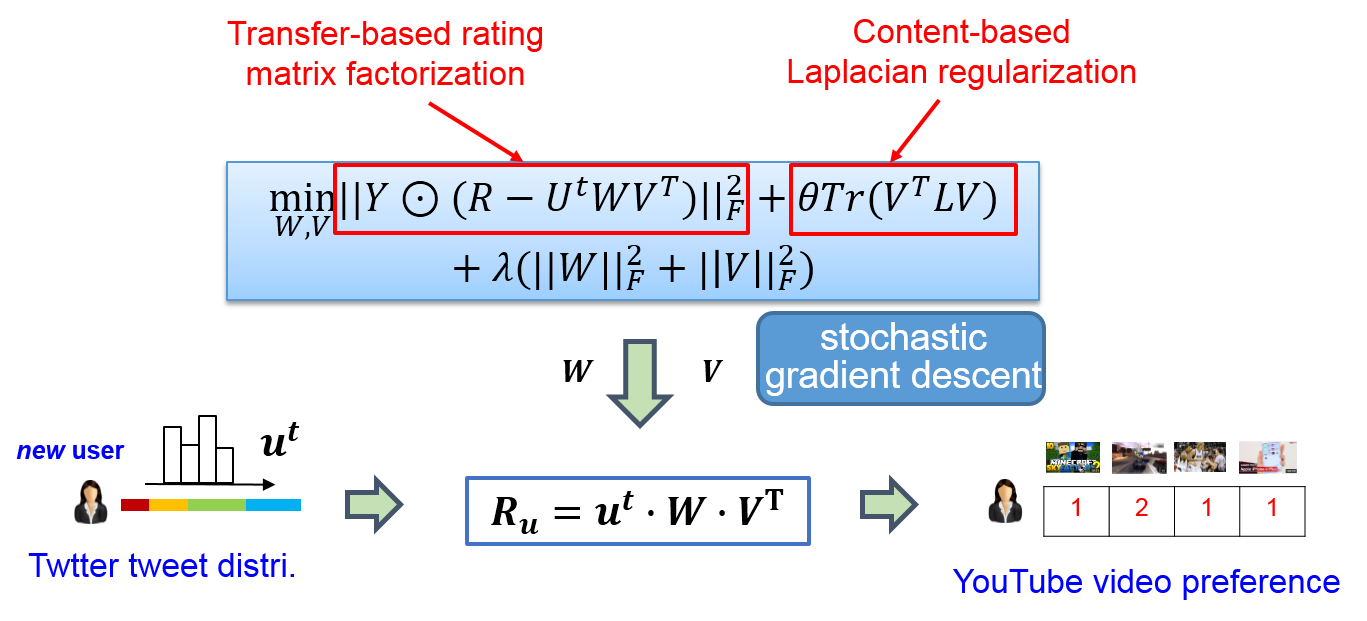Unified YouTube Video Recommendation via Cross-network Collaboration
Ming Yan, Jitao Sang and
Changsheng Xu*

Summary
(1) The ever growing number of videos on YouTube makes recommendation an important way to help users explore interested video content.
(2) YouTube video recommendation also suffers from typical problems like new user, cold-start, data sparsity, etc.
(3) Cross-network user participation phenomenon: people now usually involve in various social media networks simultaneously.
(4) This phenomenon provides huge possibility to address the cold-start and data sparsity problems by introducing rich auxiliary-network information.
(5) Our motivation in this work is: To design a unified video recommendation solution which can facilitate all the three types of users, by exploiting the cross-network user data.
.
Data justification
Two Questions:
(1) Is it easy to obtain user accounts across different social media networks?
(2) Are usersí Twitter data adequate enough to make up the shortage on YouTube video-related user data?
Observation 1: Users are voluntary to disclose their multiple-OSN accounts.

Observation 2: Userís Twitter tweeting behaviors are adequate to make up the video data shortage on YouTube.

Framework

Two Challenges:
(1) The cross-network knowledge gap between YouTube and Twitter;
(2) The inconsistency between the auxiliary and target network.
To address the above challenges, we propose a two-stage solution framework:
(1) Auxiliary-network Data Transfer: To estimate a coarse YouTube user model by only transferring the tweet behaviors..
(2) Cross-network Data Integration: To design a data fusion method to update the user model, by considering both the transferred user model from Twitter and observed user behaviors on YouTube.
Auxiliary-network Data Transfer

In this stage:
(1) We first conduct topic modeling on usersí tweeting data to represent the Twitter users on some generalized topic space.
(2) Then we assume that the correlations between the Twitter and YouTube behaviors are embedded in a transfer matrix W, by which the userís tweeting topical distribution can be mapped to a YouTube latent factor space. With the transferred user model and YouTube videos represented in the same latent space, we can directly estimate the usersí video preferences.
The key lies in how to learn the cross-network transfer matrix W to address the knowledge gap problem.

Cross-network Data Integration
For light and heavy users, the estimated preferences from Twitter and the observed behaviors on YouTube may be inconsistent. It is critical to align the two user models, and balance their contributions in the final recommendation.

The key during this process lies in how to address the inconsistency problem.
In this stage, we view the transferred user model UtW as a user prior and update the user model in a matrix factorization model.

Experiments
Overall performance comparison
We view the personalized video recommendation as a top-k prediction problem and adopt top-k F-score as the evaluation metrics.
Regarding the performance:
(1) Most of the single network-based baselines canít address the new user problem, our approach get acceptable performance on new user by only leveraging the twitter data.
(2) For light users, our methods get superior performance than the four single-network baselines, which demonstrate the advantage of exploiting auxiliary-network information for help.
(3) For heavy users, the crossIntegration method can further improve the performance by considering both the target and auxiliary network information.

Visualization of the obtained transfer matrix
To further interpret the mechanism of the proposed solution, we made some visualization to the obtained transfer matrix W.
We select two most significant topic association pairs from W, with the largest W_{ij}


Discussion
Compared with the case when users have adequate target-network behaviors, will cross-network solution on limited target-network behaviors still generate more accurate recommendation? And will cross-network solution have other advantages?

The superior performance in diversity and novelty shows the advantage of cross-network solution in discovering usersí distributed interests for serendipity recommendation.
Prospect

Publication
Unified YouTube Video Recommendation via Cross-network Collaboration [pdf]
[slides]
Ming Yan, Jitao Sang and Changsheng Xu
In ACM ICMR 2015, Shanghai, China.